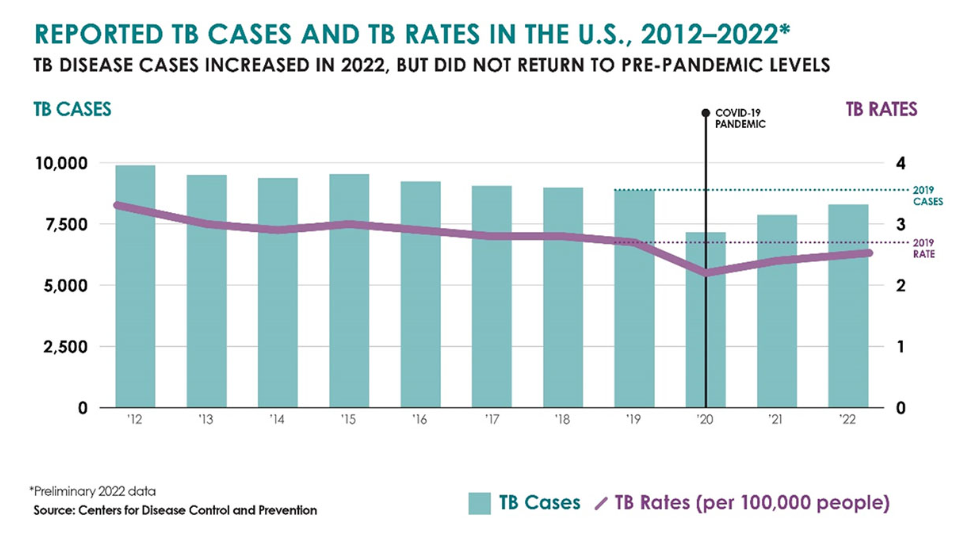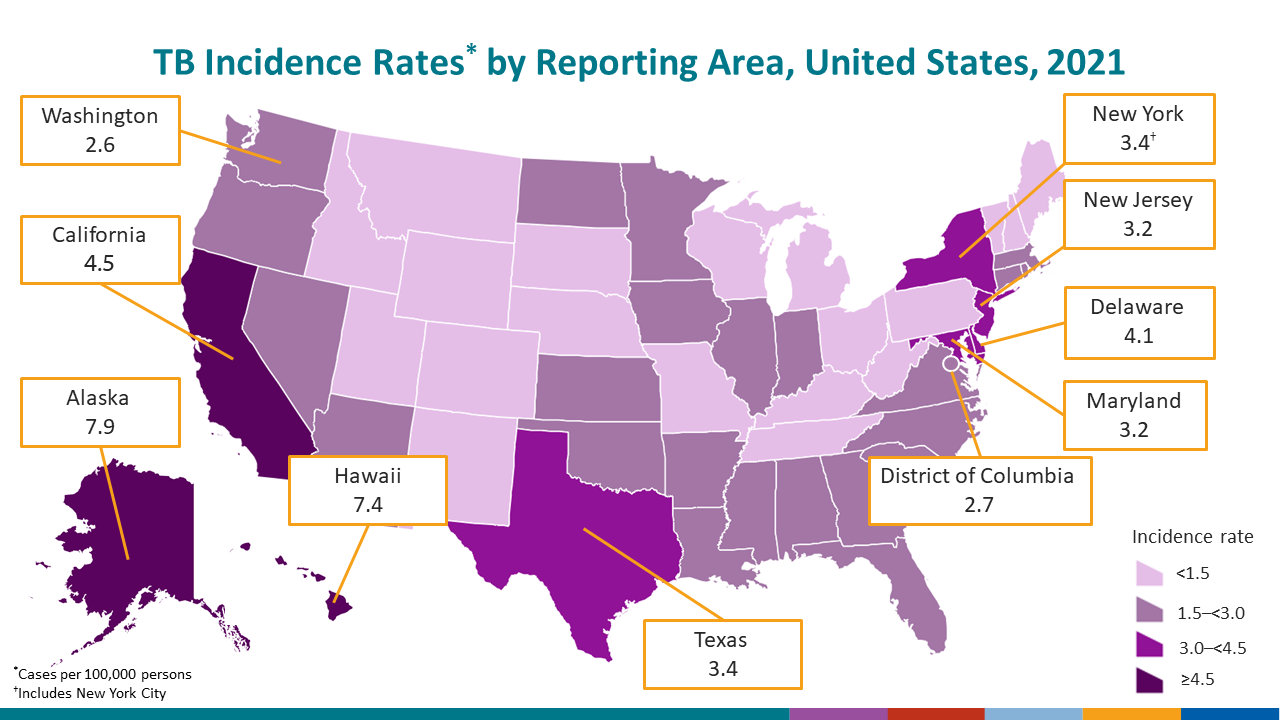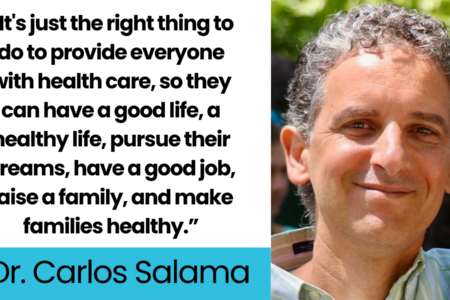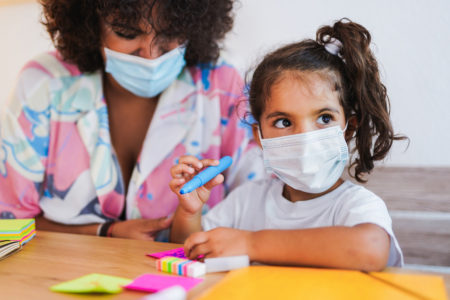
Share On Social!
US tuberculosis (TB) cases increased for the second straight year in 2022, according to new data from the Centers for Disease Control and Prevention (CDC)
Certain racial and ethnic groups, including Latinos, saw considerable increases in TB infections.
Let’s explore what this data means for Latinos, and why this population is more vulnerable to TB infections than their white counterparts.
What is Tuberculosis?
TB disease is caused by a bacterium called Mycobacterium tuberculosis, according to the CDC.
TB bacteria spreads through the air and usually targets the lungs but can attack any part of the body such as the kidney, spine, and brain.
If not treated, TB disease can be fatal.
However, not everyone who becomes infected with TB will develop TB disease.
Sometimes, TB bacteria can “sleep” in the body for years without causing any symptoms or harm to the infected person. These latent TB infections (LTBI) are not contagious but can become an active infection at any time without treatment, according to the CDC.
Symptoms of Tuberculosis Disease
Symptoms of TB disease depend on where the infection is in the body, according to the CDC.
If the infection is in the lungs, symptoms may include a bad cough that lasts three weeks or longer, pain in the chest, and coughing up blood or phlegm.
Other symptoms of TB disease include weakness or fatigue, chills, and fever.
Tuberculosis Disparities
Anyone can get TB disease.
But certain groups, such as Latinos and incarcerated and homeless individuals, are more vulnerable to TB because of social, economic, and demographic factors.
For instance, Latinos are more likely to be born in or travel to a country with a higher rate of TB disease, including South America, according to the CDC.
They may also live in multi-family housing and populated neighborhoods where airborne diseases can rapidly spread.
Additionally, Latinos carry a heavier burden of disease, such as HIV, cancer, and diabetes, which can weaken the immune system and make them more vulnerable to TB infection, according to the CDC.
Latinos are also the largest uninsured racial and ethnic group in the US and lack access to quality healthcare, which further impacts their overall health and vulnerability to infectious diseases, such as TB.
All these factors contribute to significant Latino health disparities in TB cases.
In fact, Latinos have a nine times higher TB case rate than Whites and accounted for 30.6% of all US TB infections in 2021, according to the CDC.
Texas (40.2% Latino) and California (40.2% Latino), two states with high Latino populations, have some of the highest TB infection rates.
Fortunately, with treatment, most cases of TB can be cured.
Many public health departments and clinics offer free or reduced cost TB disease treatment, which is critical for low-income patients, such as Latinos.
However, TB disease treatment can still be costly for Latinos if home isolation is required, which may result in lost wages for low-income Latinos who lack paid sick leave.
Treatment for LTBI does not require home isolation.
Rise of Tuberculosis Cases
While TB is largely controlled in the US, the new CDC data reveals that rates of the disease increased in 2021 and 2022 after a decline from 2012 to 2020.
TB remains the world’s leading infectious disease killer, according to CDC.

“The message is loud and clear – TB is still here. For the second year in a row, TB disease cases in the US have continued to rise, with concerning increases among young children and other groups at increased risk for TB disease,” Dr. Philip LoBue, Director of CDC’s Division of Tuberculosis Elimination, said in a press release.
“Communities, providers, and public health partners must work together to make sure we are reaching the right people with testing and treatment, so we can prevent and stop the spread of TB.”
Tuberculosis Prevention
While a vaccine for TB exists and is used in other countries, it is not widely used in the US because it does not always protect people against the disease and there is a comparatively low risk for TB infection in the US, according to the CDC.
Unfortunately, drug-resistant strains of TB are developing, creating a critical need for a more effective TB vaccine.
In the meantime, federal agencies such as the CDC are tackling the rise of TB infections from multiple angles. These include TB awareness and education, researching more effective TB treatment options, and making sure healthcare providers know about the latest TB diagnostics and LTBI treatment options.
Learn More About Tuberculosis in Latinos
The CDC offers the following resources in English and Spanish to learn more about TB.
- TB Personal Survivor Stories (Spanish)
- Patient Education Materials Series (English, Spanish, Tagalog, Vietnamese)
- TB website that provides Spanish-language TB information on exposure, testing, and treatment
- Questions and Answers About Tuberculosis (available in multiple languages)
- Video: 5 Things to Know about TB (English, Spanish)
You Have a Voice for Health Equity
You can help create healthier environments to protect Latinos and all people against TB and other health threats.
Select your county and get a Health Equity Report Card by Salud America! at UT Health San Antonio.
In your report card, you will see maps, data, and gauges to compare health equity issues, including healthcare access and income level, to the rest of your state and nation.
You can email your Health Equity Report Card to local leaders to stimulate community change. Use the data in your materials or share on social media to raise awareness.
Get your Health Equity Report Card!
Explore More:
Infection ControlBy The Numbers
142
Percent
Expected rise in Latino cancer cases in coming years





[…] The pandemic is another chapter in the bitter story of American racism and inequality. Black and Latinx people are being infected and are dying at much higher rates than white Americans. Many people of […]
[…] coronavirus has killed over 61,000 Latinos in America according to the CDC, accounting for over 18.2% of the total COVID deaths in the […]
[…] Whereas Hispanics make up 11% of D.C.’s inhabitants, they signify 19% of the COVID cases, and 14% of the deaths. Equally, 46% of D.C.’s residents are Black, they usually make up an alarming 75% […]
[…] and historical mistreatment. According to the U.S. Centers for Disease Control and Prevention, Latino and Black American communities are three times more likely to become infected with […]
[…] Covid pandemic has hit the Latino community particularly hard, and data from the nonprofit health equity advocacy group Salud America! shows Latinos lead in the 0-24 age […]
[…] the pandemic, Latinos took major blows, both in terms of COVID-19 cases and also from the economic recession under former President Donald Trump. Nearly half (49%) of […]
[…] the positive trend, the harm may have already been done. The pandemic has disproportionately impacted Latino communities. Reuters reported that election-related or political disinformation that […]
[…] pesar de la tendencia positiva, es posible que el daño ya esté hecho. La pandemia ha impactado desproporcionadamente Comunidades latinas. Reuters informó que la desinformación política o relacionada con las […]
[…] residentes blancos muestran una tasa mucho más baja con 10 muertes por cada 100,000 habitantes(8 9) . Los afroestadounidenses por su parte, denuncian subsistemas de salud que les segregan […]
[…] https://salud-america.org/coronavirus-case-rates-and-death-rates-for-latinos-in-the-united-states/ […]
[…] https://salud-america.org/coronavirus-case-rates-and-death-rates-for-latinos-in-the-united-states/ […]
[…] communities have the second-highest number of COVID-19 cases in the U.S. They’re also more likely to become hospitalized and die from the disease than other […]
[…] total, around 160,000 Latinos were killed by COVID-19. This accounts for 16% of the 1 million deaths in the country. The […]